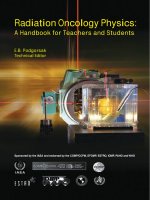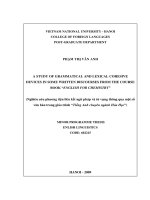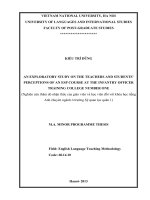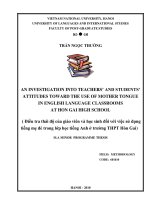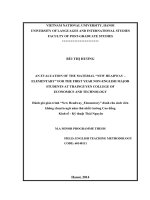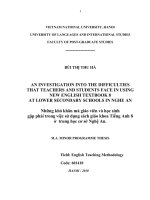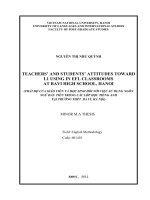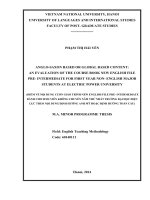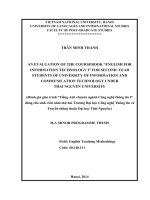An evaluation by the teachers and students about the course book english unlimited a1 starter at a public security school
Bạn đang xem bản rút gọn của tài liệu. Xem và tải ngay bản đầy đủ của tài liệu tại đây (1016.1 KB, 94 trang )
VIETNAM NATIONAL UNIVERSITY, HANOI
UNIVERSITY OF LANGUAGES AND INTERNATIONAL STUDIES
FACULTY OF POST-GRADUATE STUDIES
NGUYEN THI THU TRANG
AN EVALUATION BY THE TEACHERS AND STUDENTS
ABOUT THE COURSE BOOK ENGLISH UNLIMITED A1-STARTER
AT A PUBLIC SECURITY SCHOOL
(Đánh giá của giáo viên và học viên về giáo trình English Unlimited A1-Starter
tại một trường trung cấp Công an nhân dân)
MINOR PROGRAMME THESIS
FIELD: ENGLISH TEACHING METHODOLOGY
CODE: 8140231.01
HANOI – 2018
VIETNAM NATIONAL UNIVERSITY, HANOI
UNIVERSITY OF LANGUAGES AND INTERNATIONAL STUDIES
FACULTY OF POST-GRADUATE STUDIES
NGUYEN THI THU TRANG
AN EVALUATION BY THE TEACHERS AND STUDENTS
ABOUT THE COURSE BOOK ENGLISH UNLIMITED A1-STARTER
AT A PUBLIC SECURITY SCHOOL
(Đánh giá của giáo viên và học viên về giáo trình English Unlimited A1-Starter
tại một trường trung cấp Công an nhân dân)
MINOR PROGRAMME THESIS
FIELD: ENGLISH TEACHING METHODOLOGY
CODE: 8140231.01
SUPERVISOR: DR. TRAN THANH NHAN
HANOI – 2018
DECLARATION
I, the undersigned, declare that this thesis is the result of my own research and
has not been submitted to any other university or institution partially or wholly.
Except where the reference is indicated, no other person’s work has been used
without due acknowledgement in text of the thesis.
Hanoi, 2018
Student
Nguyễn Thị Thu Trang
i
ACKNOWLEDGEMENTS
This thesis could not have been completed without the help and support from
a number of people.
First and foremost, I would like to send my sincere thanks to my supervisor,
Dr. Tran Thanh Nhan for her enthusiastic guidance, insightful comments, and
valuable support throughout my research.
I would also like to thank all of the lecturers of the Department of Post
Graduate Studies, Vietnam National University for their useful lectures and
materials which are of great value to my thesis.
A special word of thanks is dedicated to all of my colleagues and students at
the Armed Police School for their useful information and support. Last but not least,
I owe my gratitude to my family for their support and encouragement.
ii
ABSTRACT
It is obvious that materials play an important role in language teaching and
learning, and material evaluation is one of the necessary components in the teaching
and learning process of any language. This thesis was conducted accordingly with
the aims to evaluate the suitability of the course book “English Unlimited A1Starter” for the first year students at the Armed Police School in terms of its aims,
content and methodology from the teachers and students viewpoints. The thesis
employed the quantitative and qualitative approach with two research methods:
survey questionnaire for the students as the major and informal interview for the
teachers as the supplementary. In this thesis, the material is analyzed based on the
criteria proposed by Hutchinson & Waters (1987) in order to investigate the
suitability of the course book with the students’ and teachers’ requirements. The
results indicated that the aims, content and the methodology of this material are
relatively suitable. Besides, the author also recommends some adaptation for a
better application of the course book. Hopefully, the results of the study can help
both the teachers and students better understand the course book they are using in
order to make reasonable adjustments of their own in future.
iii
TABLE OF CONTENTS
DECLARATION ...................................................................................................... i
ACKNOWLEDGEMENTS ..................................................................................... ii
ABSTRACT ............................................................................................................. iii
TABLE OF CONTENTS ........................................................................................ iv
LIST OF TABLES .................................................................................................. vi
PART A: INTRODUCTION ................................................................................... 1
1. Rationale of the study............................................................................................. 1
2. Scope and aims of the study ................................................................................... 2
2.1. Scope of the study ................................................................................................ 2
2.2. Aims of the study ................................................................................................. 2
3. Significance of the study ........................................................................................ 3
4. Research questions ................................................................................................. 3
5. Methods of the study .............................................................................................. 3
5.1. Participants ........................................................ Error! Bookmark not defined.
5.2. Instruments ......................................................... Error! Bookmark not defined.
5.3. Data collection methods/ Data analysis proceduresError!
Bookmark
not
defined.
6. Design of the thesis ................................................................................................ 4
PART B: DEVELOPMENT.................................................................................... 5
CHAPTER I: LITERATURE REVIEW ............................................................... 5
1.1. Review of previous related studies ..................................................................... 5
1.2. The roles of materials in language learning and teaching ................................... 7
1.2.1. Definitions of materials .................................................................................... 7
1.2.2. Types of materials ............................................................................................ 7
1.2.3. Roles of materials in language learning and teaching .................................... 8
1.3. Materials evaluation ........................................................................................... 8
1.3.1. Definition of materials evaluation ................................................................... 8
1.3.2. Types of materials evaluation .......................................................................... 9
1.3.3. Types of evaluators ......................................................................................... 10
1.3.4. Models of materials evaluation ....................................................................... 11
1.4. Criteria for materials evaluation ........................................................................ 14
iv
1.5. Materials adaptation ........................................................................................... 15
1.5.1. The role of materials adaptation ..................................................................... 15
1.5.2. Techniques for adaptation............................................................................... 16
1.6. Summary ............................................................................................................ 16
CHAPTER 2: METHODOLOGY ........................................................................ 18
2.1. Description of the context .................................................................................. 18
2.1.1. The setting ....................................................................................................... 18
2.1.2. Objectives of the course .................................................................................. 19
2.1.3. Course material ............................................................................................... 19
2.2. Research methodology ....................................................................................... 20
2.2.1. Participants ..................................................................................................... 20
2.2.2. Instruments ..................................................................................................... 20
CHAPTER 3: RESULTS AND DISCUSSION .................................................... 25
3.1. The suitability of the course book with the mastery of the course’s outcomes . 25
3.2. The suitability of the course book’s content ...................................................... 30
3.2.1. The suitability of language points ................................................................... 30
3.2.2. The suitability of other elements of the course book’s content ....................... 34
3.3. The appropriateness of methodology and learning conditions .......................... 41
3.4. Students’ evaluation and suggestions about the course book ............................ 48
3.5. Summary of major findings ............................................................................... 52
3.5.2. The suitability of the course book’s content.................................................... 52
3.5.3. The suitability of methodology and learning conditions ................................. 54
3.5.4. General comments about the course book ...................................................... 54
PART C: RECOMMENDATIONS AND CONCLUSIONS ............................... 55
1. Recommendations ................................................................................................. 55
2. Limitations and suggestions for further study....................................................... 57
3. Conclusion............................................................................................................. 57
REFERENCES .......................................................................................................... 59
APPENDICES............................................................................................................ I
APPENDIX 1 ............................................................................................................. I
APPENDIX 2 ............................................................................................................VI
APPENDIX 3 .........................................................................................................XVI
v
APPENDIX 4 ....................................................................................................... XVII
LIST OF TABLES
Table 1: Student’s opinion about their mastery of the course outcomes in terms of grammar
............................................................................................................................................. 26
Table 2: Student’s opinion about their mastery of the course outcomes in terms of
vocabulary ............................................................................................................................ 27
Table 3: Student’s opinion about their mastery of the course outcomes in terms of four
skills .................................................................................................................................... 28
Table 4: Students’ opinion about the necessity of the vocabulary related to the topics in the
course book .......................................................................................................................... 30
Table 5: Students’ opinion about the suitability of grammar items for their communication need
............................................................................................................................................. 32
Table 6: Students’ opinion about the suitability of the situations for their daily
communication..................................................................................................................... 33
Table 7: Students’ opinion about the topics in the course book .......................................... 35
Table 8: Students’ opinion about the parts of each unit ...................................................... 36
Table 9: Students opinion about the overall course’s proportion ............................. 37
Table 10: Students’ opinion about the format of the course book ....................................... 39
Table 11: Students’ opinion about the text types of the course book .................................. 40
Table 12: Students’ opinion about the teaching and learning fact in their class ................. 42
Table 13: Students’ opinion about suitability of the kinds of tasks in the course book ............... 43
Table 14: Students’ opinion about teacher’s technique usage frequency ............................ 45
Table 15: Students’ opinion about the suitability of the teaching aids of the course book . 46
Table 16: Teachers’ and students’ opinion about teacher’s adaptation ............................... 47
Table 17: Students’ opinion about teacher’s adaptation frequency ..................................... 48
Table 18: Students’ comments on the course book ............................................................. 49
Table 19: Student’s suggestions for a better course book usage ......................................... 50
Table 20: Students’ opinion about their favorite topics ....................................................... 51
vi
PART A: INTRODUCTION
1. Rationale of the study
English, nowadays, has become an international language spoken all over the
world. Thanks for this language; connections between nations all over the world
become possible. It is the language used in all aspects of life such as economics,
politics, science, technology, tourism, culture, and education. For this reason, it can
be assumed that the role of English language cannot be just expressed in words. In
Vietnam, the importance of English was immediately acknowledged by the
Vietnamese government and as a result the English language programs were made
compulsory beginning at secondary schools and subsequently high schools and
finally universities.
The need of using English in the crime prevention cooperation between
Vietnam and other countries in the world is increasing. Moreover, many daily
situations related to foreign criminals and factors need to be faced by the police
force. Therefore, English is taught as a compulsory subject in most Public Security
Schools in Vietnam aiming to develop four skills – listening, speaking, reading, and
writing as well as the knowledge of specific purposes in English. As a school of
Public Security system, the curriculum of the Armed Police School also consists of
English as a subject to equip the students with basic knowledge of the language to
communicate with foreigners in their job.
To master English, it is necessary to consider the factors affecting the teaching
and learning process such as learning objectives, learning outcomes, teacher’s
methods, and course books. Among these factors, course books have played an
important role in most language curricula. The reason for this is that materials,
especially course books play a vital role in exposing the students to the English
language (Dudley-Evans & St John, 2000:171). The course book determines the
classroom activities, influences teachers’ teaching methods, and the students’ roles.
Nunan (2003:226) predicates that course book is the main element of any
1
curriculum and “it is difficult to imagine a class without book”. The course book
chosen at the Armed Police School is English Unlimited A1- Starter which is
written by Adrian Doff and published by Cambridge. It is used for the first year
students and has been used for two years, however, since then no research on the
course book evaluation has been carried out by the school administrators prior to the
introduction of the course book to recognize its strengths and shortcomings, and to
judge to what extent the course book meets students and teacher’s needs. For this
reason, I will choose the thesis “An evaluation by the teachers and students
about the course book English Unlimited A1- Starter at a Public Security
school”. It is a good opportunity to reveal the suitability of the material for the
students’ level from the students’ and the teachers’ views so that adaptation can be
made to gain better results of teaching and learning.
2. Scope and aims of the study
2.1. Scope of the study
This study will focus on evaluating the course book “English Unlimited A1 –
Starter”. The researcher bases on the Hutchinson and Waters (1987)’s criteria for
evaluation with focus on the three following criteria: aims of the materials,
content of the materials (in terms of language use, skills, topics, parts of unit,
overall course’s proportion, format of course book and text types), and
methodology (in terms of teaching and learning facts, kinds of tasks, teaching
techniques, and teaching aids). Research participants are primarily confined to the
teachers of English who have been teaching the material and the first year students
at the Armed Police School.
2.2. Aims of the study
From the concrete situation of the teaching and learning context, this study
aims to evaluate the appropriateness of the course book “English Unlimited A1Starter” for the first year students at the Armed Police School from both teachers
and students’ viewpoints with the hope that the collected information for
improvement of the course book will be adapted to make it more effective for future use.
To be more detailed, this study aims to:
2
- evaluate the course book “English Unlimited A1- Starter” from the viewpoints
of the teachers and students at the Armed Police School to identify its strengths,
deficiencies and weaknesses.
- offer suggestions for adaptation of the materials based on the major findings.
3. Significance of the study
The findings of the study will be useful not only to the researcher, and the
course book designer but also to the teaching staff and the first year students at The
Armed Police School. Besides, the findings will suggest some adaptation in order to
improve the quality of the materials which is used for the students at the Armed
Police School. More importantly, it is hoped that the research results will make
some contributions to the field of material evaluation in specialized Vietnamese
contexts.
4. Research questions
To achieve the aims of the thesis, the following research questions are
proposed:
-
How do the teachers at the Armed Police School evaluate the course book?
-
How do the first year students at the Armed Police School evaluate the
course book?
-
To what extent do teachers and students at the Armed Police School want to
alter in the course book?
5. Methods of the study
The study is carried out in form of a survey research, conducted by the
writer herself. Both quantitative and qualitative methods are used in order to
get a full view of the evaluation by the teachers and the students about the
course book English Unlimited A1- Starter at the Armed Police School.
To collect desired data, two research instruments are made use of,
namely survey questionnaire and interview. As for the first instrument, there
is a questionnaire consisting of 5 sections which deliver for 100 first year
students. The second instrument used interview for 07 teachers with 12
3
questions. These two instruments aim to answer three research questions of
the study.
6. Design of the thesis
Part A: Introduction
This part introduces rationale, scope, aims, significance, research questions,
methods, and design of the study.
Part B: Development
This part consists of three chapters:
Chapter 1: Literature Review
Theoretical background relevant to the topic and critical survey of
related articles, books and other resources are presented.
Chapter 2: Methodology
This chapter is devoted to the methodology used in the study.
Chapter 3: Results and Discussion
This chapter deals with the findings drawn out from the analysis of the
data.
Part C: recommendations and conclusions
This chapter summarizes the main points discussed in the paper
and some limitations of the study. Besides, recommendations for
adaptation of the course book and recommendations for further
research are presented.
4
PART B: DEVELOPMENT
CHAPTER I: LITERATURE REVIEW
This chapter presents a brief review of the literature relevant to the study.
It consists of the theory of materials, materials evaluation, and materials
adaptation.
1.1. Review of previous related studies
The course book evaluation is always the center of many researchers’
attention. Up to now, there have been a large number of studies on course book
evaluation. The following are some studies of this topic. All of them share the
common purpose in investigating the suitability of the used course book and making
some adaptation if necessary.
An evaluation carried out by Osman Dulger about English Language Teaching
Coursebooks used in Turkey. The study was a descriptive survey study which was
conducted in Turkey during the 2013-2014. This study aimed at finding out teacher
views on the course books. The participants were 118 English language teachers
attended the survey to provide views on the language textbooks they use in their
classes. The instrument used in the study was a checklist consisting two main
categories as “general attributes” and “teaching-learning content” where totally 14
sub-dimensions and 38 items were included. Results of the study
indicated
findings in favor of the English language coursebooks used in Turkey in some
categories while suggesting less favorable results in some categories as well.
The study conducted by Ahmed Shameem (2016) provided an evaluation of
Effective Communication Skills course book that had been introduced as a pilot
project implemented in 2011 by the Ministry of Higher Education, Malaysia. The
aims of the study was to find out the suitability of Effective Communication Skills
course book from the students’ perspectives, then investigate the strengths and
weaknesses of this course book. The data in the study was collected on the basis of
materials
study and
questionnaires. The results of the study indicated that
5
although the course book had some shortcomings, there was a general satisfaction
about this textbook as it was exclusively produced by the local experts for the
tertiary level. The writer also made some suggestions and recommendations for the
improvement of the Effective Communication Skills.
In Vietnam, Dao Thi Sang (2011) conducted a study to evaluate the text
book “New English File Pre-intermediate” for the first year non-major students at
University of Social Sciences and Humanities. The study aimed to evaluate the
textbook New English File pre-intermediate from both lecturers and students’
viewpoints and then investigated the ways teachers adapt the book to meet the
students’ needs and interests. The researcher conducted an action research using
survey questionnaires, teachers’ informal interviews, and teacher’ weekly selfreports. The findings of the study showed that the course book “New English File
Pre-intermediate” was used more effectively by both teachers and students at
University of Social Sciences and Humanities. However, the study also addressed
some strengths and weaknesses of the material and made some suggestions would
be given for better application of the material.
In 2015, Nguyen Thi Nhat carried out a study to evaluate the course book
“English Unlimited A1” for English beginners at Thang Long Canon factory. With
the attempt to investigate the suitability of the course book the researcher based on
the model of McDnough and Shaw (1993) and used teacher interview and student
questionnaire to collect the data. The results indicated that the course book was
suitable for English beginners, but some adaptations were made in order to future
use of the course book.
In this thesis, the researcher also conducts an evaluation of the course book
English Unlimited A1- Starter for the first year students at The Armed Police
School to investigate the suitability of the course book in terms of aims, content and
methodology. However, there are some differences in some aspects. The first
difference is that the researcher bases on the criteria by Hutchison and Water
(1987). The second difference is related to instruments used in the study. In this
6
study, document analysis, a questionnaire consisting of 5 sections for the students,
and interviews for teachers are employed with the aim to ensure the reliability. As a
result, it is hoped that the study will yield valuable and reliable findings.
1.2. The roles of materials in language learning and teaching
1.2.1. Definitions of materials
Brown (1995:139) defines materials as “any systematic description of the
techniques and exercises to be used in classroom teaching”. Meanwhile, Tomlinson
(1998: 66) defines: “Materials include anything, which can be used to facilitate the
learning of a language. They can be linguistics; visual, auditory, kinaesthetic and
they can be presented in print, through live performance or display, or on cassette,
CD-ROM, DVD or the internet”. Further, Nunan (1988:98) asserts “Materials are
the tangible manifestation of the curriculum in action. They are in fact omnipresent
in the language classroom and it is difficult to imagine a class without books”.
Richards (2001:251) states “in case of inexperienced teachers, materials may also
serve as a form of teacher training-they provide ideas on how to plan and teach
lessons”. These materials need to be looked at within a given context and a syllabus
derived from a specific approach (McDonough and Shaw, 2003: 4-14).
1.2.2. Types of materials
According to Richards (2001), materials in use can vary from a textbook,
institutionally prepared materials or the teacher’s own materials. More specifically,
McGrath (2002) divides materials into four main types:
Published materials: This type of materials can be books and reference materials as
dictionaries, grammars, advice on language learning, test practice materials, tapes
accompanying course books, or supplementary books.
Authentic materials: Taken from real life, these consist of newspaper, magazines,
user manuals, leaflets and brochures, foreign mission information, letters faxes,
email, emails, videos ( films or documentaries), and songs.
Adapting and supplementing published materials: There are ones that have been
adapted or supplemented in some way. These cut up materials can be self- standing
7
or deliberately designed to supplement the course books.
Specially-prepared materials: For self-access activities, this type of materials
proves to be useful as there is always a need for material that is more precisely
tailored to the needs of students working on their own.
1.2.3. Roles of materials in language learning and teaching
It can be assumed that materials play an important part in any language
program. The roles of materials are mentioned by many authors in literature.
According to Sheldon (1988:237), a textbook “represent the visible heart of any
ELT program.” Hutchinson and Tores (1994:315) claim “No teaching-learning
situation, it seems, is complete until it has a relevant textbook.” Richard (2001)
emphasizes that materials provide a basis for the content of the lesson, the
appropriate proportion of skills taught, and the type of language practice students
take part in. Moreover, useful teaching materials are of great assistance to
inexperienced teachers or poorly trained teachers. They can serve as “a form of
teacher training” (Richards, 2001: 251) and teachers can get ideas on how to plan
and teach the lesson from the materials.
Cunningsworth (1995) suggest course books have multiple roles in ELT and
server as:
A resource for presentation material (spoken and written)
A source of activities for learner practice and communicative interaction
A reference source for learner on grammar, vocabulary, pronunciation, etc
A source of stimulation and ideas for classroom language activities
A syllabus (where they reflect learning objectives which have already been
determined)
A resource for self – directed learning or self- access work
A support for less experienced teachers who have yet to gain in confidence
1.3. Materials evaluation
1.3.1. Definition of materials evaluation
Evaluation plays a crucial role in curriculum development as it allows
8
instructors, material designers and administrators to assess the effectiveness and
efficiency of a particular language program or any of its components and make
informed decisions about how to proceed.
As an important factor of English teaching curriculum, materials need to be
evaluated in order to alter if necessary as Hutchinson and Waters (1987: 96) states
“evaluation is a matter of judging the fitness of something for a particular purpose”.
Similarly, Tomlinson (2003:15) points out materials evaluation is “a procedure that
involves measuring the value, or potential value, of a set of materials [which]
involves making judgments about the effects of materials on the people using
them.” According to Brown (1995: 218), evaluation is “the systematic collection
and analysis of all relevant information necessary to promote the improvement of a
curriculum, and assess its effectiveness and efficiency, as well as the participants’
attitudes within the context of the particular institutions involved.” It can be inferred
from this definition that information be gathered and analyzed in a systematic
manner and that only relevant information should be included, that is, information
must necessarily filtered so that irrelevant information can be ignored.
It can be assumed that the definition of materials evaluation depends on
different author’s view. In my view, these authors share the same view that
materials evaluation is process to find out whether the course book meets learners’
needs or not. As a result, it will increase the strengths and minimize the drawback of
the course book.
1.3.2. Types of materials evaluation
Materials evaluation is classified by different authors. Robinson (1991:59)
divided materials evaluation into three types: preliminary, formative, and
summative. According to Cunningsworth (1995), materials evaluation is classified
in to three kinds: Pre-use evaluation, in-use evaluation, and post-use evaluation.
Despite the fact that different authors have different concepts to classify material
evaluation, these concepts are similar.
Pre-use (preliminary) evaluation is conducted before starting a course. This
9
kind of evaluation aims to examine the suitability of the materials for the learners
who are taking part in the course in the future.
In-use (formative)) evaluation takes place while the materials are in use. The
results from the evaluation can use to suggest the replacement of the materials.
Post-use (summative) evaluation is carried out after the course is ended. This
kind of evaluation helps evaluators find out the strengths and weaknesses when
using the materials. Thank for the evaluation, the teachers can make a decision
whether to continue using the materials in the future or not.
Among many different kinds of materials evaluation, it is necessary to decide
what kind of materials evaluation will be suitable for the context. For The Armed
Police School, English Unlimited A1-Starter has been used for two years, the
researcher decides to use post-use evaluation to examine whether the materials are
suitable for the learner’s or not and give some suggestions for future improvement.
1.3.3. Types of evaluators
According to Richard’s view (2001), evaluators are divided in to two types:
outsides and insiders.
Outsiders are those who have not been involved in the program since they do
not directly control the teaching program. They will have their own points of view
on language teaching method and they may not fully understand the teaching and
learning situations. As a result, as Robinson (1991) states that they may be
unsympathetic and they may need more time for them to get know about the local
situation such as leaner’s needs, facilities as well as constraints, so it may be
difficult for them to have exact judgments and realistic recommendations of the
program.
Insiders are those have already involved in the language program such as
teachers, students, and course and material designers. They are believed to
understand the situation well. To emphasize the insiders’ role as evaluators,
Richards (2001:296) states that the involvement of the insiders plays an important
part in the success of evaluation because “as a consequence, they will have greater
10
degree of commitment to acting on it results”. Furthermore, insiders especially
teachers can monitor and control the material being used. Therefore, they are
capable of determining to what extent the material works for their purposes.
However, in the words of Dulley- Evans and John (1998), insiders may suffer from
several disadvantages when they can be “too closed and involved or lack expertise”.
Therefore, the evaluation may be influenced by their subjective viewpoints and their
teaching experience.
In this thesis, the course book English Unlimited A1-Starter which being
taught the first year English students at the Armed Police School is evaluated by
outsiders as well as insiders. Among the evaluators, seven teachers and 100 students
have the invitations to take part in the study are considered as insiders and the
researcher who is currently doing this thesis is an outsiders.
1.3.4. Models of materials evaluation
There are various models suggesting by different authors to evaluate materials.
In the light of the approaches to the materials evaluation, the evaluation models can
be referred to as macro and micro evaluation models. Macro evaluation models
focus on the overall assessment of course books and/or materials in terms of the
criteria they suggest whereas micro evaluation models focus on an in-depth analysis
of particular tasks for particular groups of learners. The most popular models are
presented by Hutchinson and Water (1987), Ellis (1997), and McDonough & Shaw
(1993).
Model by Hutchison and Water (1987)
The model introduced by Hutchinson and Water (1987) is a macro evaluation
aiming to assess the workability of an entire set of materials. The first step is to
define criteria which the evaluation is based on. The second step is to find out the
subjective analysis. The third step is to determine the objective analysis. The last
step is carried out to compare the findings with the materials requirements to
evaluate the match between the materials and the requirement. It can be seen that
Hutchinson and Water (1987) recommended an effective model. This model also
11
has a description of stages and criteria which are introduced systematically. It helps
the evaluators know exactly what must be done in order to analyze the materials
compared with the requirements of the course.
DEFINE CRITERIA
On what bases will you
judge your materials?
Which criteria will be
more important?
SUBJECTIVE ANALYSIS
OBJECTIVE ANALYSIS
What realizations of the
criteria do you want in
your course?
What realizations of the
criteria do you want in
your course?
MATCHING
How far does the material
match your needs?
Figure 1: Materials evaluation model of Hutchinson and Waters (1987;97)
Model by Ellis (1997)
This model is a micro evaluation. In Ellis’s view (1997), by focusing on the
particular tasks, micro- evaluation could give the supporting to a systematic
evaluation of materials after using. He proposed a model that identified some basic
steps of task evaluation as follow:
1. Choosing the task to follow
2. Describing the task with specification of input, procedures, language
activities and outcomes
3. Planning the evaluation with reference to the dimensions above
4. Collecting information before, while and after the task was used, and what
how the task performed
12
5. Analyzing the information collected
6. Reaching the conclusions and making recommendations for future
teaching
7. Writing the report
Model by McDonough and Shaw (1993)
McDonough and Shaw have combined the macro and micro evaluation. In this
model, they mentioned a three- stage evaluation including internal, external, and
overall evaluation.
Macro- evaluation→ inappropriate/ potential→
↓
EXIT
Micro- evaluation→ inappropriate/ appropriate → adopt/ select
↓
EXIT
Figure 2: Materials evaluation model by Mc Donough and Shaw (1993:75)
It is clearly seen from the chart that McDonough and Shaw suggest a logical
procedure for materials evaluation. The external evaluation offers, a brief
“overview” of the materials from the outside. It consists of an examination of the
claims made on the cover of the students’ and teacher’s books, the introduction and
the table of contents. The evaluation, at this stage, aims to find out whether the
material is potentially suitable for more detailed analysis. The internal evaluation
requires “an in depth investigation into the materials” (p. 75). It is strongly claimed
that in order to do an effective internal investigation of the materials, at least two
units or more units of the book are required to be examined. The internal evaluation
is normally conducted after the external evaluation. The overall evaluation is the
process in which “there is a need to make an overall assessment of the material as to
the suitability of the materials by considering the parameters, namely the usability
factor, generalizability factor, adaptability factor and flexibility factor” (p.75).
In this thesis, the researcher used the model by Hutchinson and Waters (1987)
13
which is the most suitable for the research context. In this thesis, the researcher only
focus on subjective analysis.
1.4. Criteria for materials evaluation
Criteria for materials evaluation are suggested by many different scholars.
According to Sheldon (1998: 241) “not all the criteria described would be deployed
simultaneously, nor is the list definitive.” Therefore, it is necessary to consider the
factors related to a specific teaching and learning context. He presents criteria that
can be used to evaluate the materials. According to him, the criteria consist of
rationale, availability, user definition, layout/ graphic, accessibility, linkage,
selection/
grading,
physical
characteristics,
appropriateness,
authenticity,
sufficiency, cultural bias, educational validity, stimulus/ practice/ revision,
flexibility, guidance, and overall value for money. Because of the context of the
study, the criteria of Hutchison and Waters (1987) seem to be the most suitable. The
criteria include four main criteria for materials evaluation which each evaluator
should pay attention to: the aims, the content and the methodology.
(i) The audience of the materials requires the evaluator should collect
information from the learners in order to know if the materials meet the learner’s
needs or not.
(ii) The aims of the materials help the evaluator to check whether the materials
match the objectives of the course or not.
(iii) The content of the materials plays the most important role in materials
evaluation process. The evaluator has to find out whether the content of the
materials is appropriate to the students in terms of language description, language
points, macro skills and their proportion, and micro skills. Moreover, it is essential
for the evaluator to know whether the material’s text types meet the requirements of
the course or not. Besides, the way the content is organized and sequenced within a
unit and throughout the course need to be evaluated.
(iv) The methodology used in the materials is an important factor when
evaluating the materials. It is necessary to indicate if the theories of learning on
14
which the course is based are in line with those of the materials under evaluation. In
addition, evaluators should measure whether the learners’ needs are the ones the
materials intended to. Moreover, the appropriateness between the kinds of
exercises/ tasks and the course requirements is also examined. An important factor
in methodology needs to be evaluated are the teaching and learning techniques:
whether the teaching and learning techniques that can be used with the materials are
those required by the course and effective for the learners. Besides, it is useful to
discover that the current teaching aids are what required by the materials. Another
factor which an evaluator needs concern is that the materials provide teachers with
guidance and support for the course. Furthermore, it is essential to examine whether
the materials are flexible in order to be used in different sequence to match the
teaching context.
Other criteria: In words of Hutchinson and Water, it is necessary for the
evaluators to consider other criteria such as the price and availability of the
materials.
1.5. Materials adaptation
1.5.1. The role of materials adaptation
Materials are adapted in order to achieve the objectives that the people have
identified, defined and set for learning contexts. It is obvious that the materials need
to be adapted in order to facilitate the learning process through identifying the
learning problems so that learners are able to internalize the learning content in a
natural way. Materials are adapted because of some following reasons:
-
To make the materials more suitable for the circumstances in which it is
being used, i.e. to mound it to the needs and interests of learners, the
teacher’s own capabilities and such constraints as time, or as McDonough
& Shaw (1993:85) put it: “to maximize the appropriateness of teaching
materials in context, by changing some of the internal characteristics of a
course book to better suit our particular circumstances.
-
To compensate for any intrinsic deficiencies in the material, such as
15
linguistic inaccuracies, being out of dated, lack of authenticity (Madsen
and Bowen, 1987)
-
To help teachers to maximize the value of the book for the benefit of their
learners. Hence they can improve it so that it is suitable for the particular
situation. (Shannon, 1987)
-
“To make the materials of more value to the students using them” by
adjusting them towards different classroom realities. (Tomlinson, 2012: 151)
1.5.2. Techniques for adaptation
McDonough (2013) mention five primary techniques for materials adaptation.
Adding: Adding simply means that materials are supplemented by putting
more into them. Adding does not have to be made onto the end of something.
Adding by extension is when teachers supply more of the same content, where
adding by expansion is when teachers go further by bringing about the qualitative
and quantitative change.
Deleting: It is the opposite technique of addition. It refers to reducing the
length of materials by subtracting from it. Similarly, deletion could be qualitative or
quantitative.
Modifying: This technique can be categorized in to two small techniques: re–
writing and re-structuring. Re-writing is about the modification of linguistic content
while re-structuring refers to the classroom organization.
Simplifying: The technique of simplification is one type of modification,
namely, a rewriting activity. The main application of this technique has been to
texts, most often to reading passages. Teachers can simplify according to sentence
structures or content.
Re-ordering: This technique refers to the possibility of putting the parts of a
course book in a different order. This may mean adjusting the sequence of
presentation within a unit, or taking units in a different sequence from that
originally intended.
1.6. Summary
This chapter is a brief review of literature on materials, materials evaluation
16
and materials adaptation. It consists of five sections. The first section reviews some
previous related studies. The second section is about definition of materials, types
of materials and roles of materials in language learning and teaching. The third
section mentions main issues in material evaluation such as definitions, types of
materials evaluation, models of materials evaluation, and criteria for materials
evaluation. The fourth section presents criteria for materials evaluation. The last
section provides some issues in materials adaptation. For these reasons, this chapter
can be seen as the theoretical foundation for the applications for the next chapter
and the improvement that should be made to the course book English Unlimited A1
–Starter for the first year students at The Armed Police School.
17

